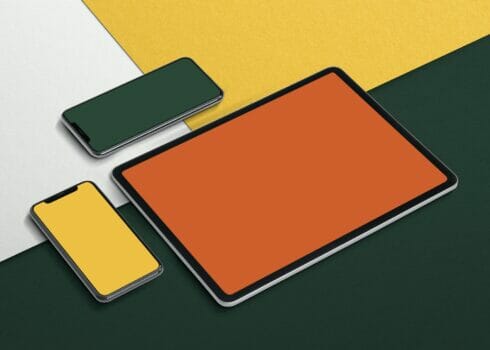One of the most important features of a smartphone is its screen specifications. It’s quality plays a vital role in determining the overall user experience. This article will provide an in-depth analysis of the main screen specifications that determine the quality of a smartphone display.
Screen Resolution
Screen resolution refers to the number of pixels displayed on the screen. The higher the resolution, the more detailed the image appears. Smartphones typically offer various resolutions, such as HD (720p), FHD (1080p), QHD (1440p), and even 4K (2160p).
The pixel density is also important, as it determines the level of detail and sharpness. A comparison table of different resolutions and their respective pixel densities can be found below.
| Resolution | Pixel Density |
|---|---|
| HD | 294 PPI |
| FHD | 440 PPI |
| QHD | 538 PPI |
| 4K | 804 PPI |
In general, the higher the resolution, the better the image quality. However, higher resolutions also consume more battery power and require more processing power to display.
| Price Range (USD) | Average Screen Resolution |
|---|---|
| 0-200 | 720 x 1520 pixels |
| 200-400 | 1080 x 2340 pixels |
| 400-600 | 1080 x 2400 pixels |
| 600-800 | 1080 x 2400 pixels |
| 800+ | 1440 x 3200 pixels |
Screen Type
The screen type is another critical factor in determining the quality of a smartphone display. The most commonly used types are LCD, OLED, and AMOLED.
LCD (Liquid Crystal Display)
LCD screens use a backlight to illuminate the display. Liquid crystals within the screen block or allow the light to pass through, creating the images on the screen. LCD screens have been around for a long time and are still widely used in mobile phones.
Pros of LCD screens:
- Affordable
- Bright and vibrant colors
- Good visibility in bright light
Cons of LCD screens:
- Poor contrast ratio
- Blacks may appear as a dark gray
- Not as energy-efficient as OLED or AMOLED
OLED (Organic Light Emitting Diode)
OLED screens are made of organic materials that emit light when an electric current is passed through them. OLED screens have been gaining popularity in recent years and are used in many high-end mobile phones.
Pros of OLED screens:
- Excellent contrast ratio
- True blacks
- Energy-efficient
- Thin and flexible
Cons of OLED screens:
- Expensive
- May suffer from burn-in
- Not as bright as LCD screens in bright light
AMOLED
AMOLED is a specific trademarked term used by Samsung to describe their own proprietary OLED technology.
| Technology | Brightness | Contrast Ratio | Color Reproduction | Refresh Rate | Thickness | Price | Life Span |
|---|---|---|---|---|---|---|---|
| LCD | Generally bright, but may struggle in direct sunlight | Poor contrast ratio compared to OLED | Good color reproduction, but not as accurate as OLED | Typically 60Hz | Thicker than OLED | Generally more affordable than OLED | Can last several years with proper care |
| OLED | Generally bright, performs well in direct sunlight | Excellent contrast ratio | Accurate color reproduction, with true blacks | Can have higher refresh rates, up to 120Hz | Thinner and more flexible than LCD | Generally more expensive than LCD | Lifespan may be shorter due to potential burn-in issues |
Refresh Rate
The refresh rate of a smartphone screen refers to how many times per second the display refreshes its image. A higher refresh rate provides a smoother and more fluid experience, especially when scrolling through content or playing games.
Most smartphones have a refresh rate of 60Hz, but some newer models feature 90Hz, 120Hz, or even 144Hz refresh rates. However, higher refresh rates consume more battery power and require more processing power from the device.
Touch Sampling Rate
Touch sampling rate refers to how often the phone’s touchscreen registers and processes touch inputs. A higher touch sampling rate provides a more responsive and accurate touchscreen, especially for gaming and fast-paced activities.
PWM Frequency
PWM (Pulse-Width Modulation) is a technique used to control the brightness of a screen’s backlight. It works by rapidly turning the backlight on and off at a certain frequency, and the average of these on/off cycles determines the brightness level. A higher PWM frequency can reduce eye strain and prevent headaches, especially for those who use their phones for long periods.
Color Gamut
Color gamut refers to the range of colors that a display can produce. There are different color gamuts available in smartphones, such as sRGB, DCI-P3, and Adobe RGB. The sRGB color space is widely used and covers a smaller range of colors than the other color spaces. On the other hand, DCI-P3 covers a wider range of colors and is commonly used for HDR content. Adobe RGB is mainly used in professional photography and design.
The difference in color gamuts affects how colors appear on the screen. Smartphones with a wider color gamut produce more vibrant and accurate colors. However, it is important to note that not all content is optimized for wider color gamuts, so it is possible that some colors may appear oversaturated or unrealistic.
HDR
HDR stands for High Dynamic Range and refers to a technology that allows displays to show a wider range of brightness and contrast levels. HDR content has more detail in the dark and bright areas of the screen, resulting in a more immersive viewing experience. There are different HDR standards available in smartphones, such as HDR10, HDR10+, and Dolby Vision. HDR10 is the most common standard, while Dolby Vision offers the best performance.
Color Depth
Color depth is the number of colors a screen can display. An 8-bit screen can display 16.7 million colors, while a 10-bit screen can display 1.07 billion colors, with 10-bit color offering more accuracy and smoother transitions between colors.
JNCD and Delta E
When it comes to color accuracy, two metrics that are often used to measure a screen’s performance are JNCD and Delta E. JNCD stands for “Just Noticeable Color Difference” and is a measure of how accurately a screen can reproduce colors. The lower the JNCD score, the more accurate the color reproduction.
Delta E, on the other hand, is a measure of the difference between the intended color and the actual color produced by the screen. A Delta E score of less than 1 is considered excellent, while a score of 3 or higher is considered unacceptable.
Conclusion
When it comes to choosing a smartphone, the screen specifications are an important factor to consider. Screen resolution, screen type, refresh rate, touch sampling rate, PWM frequency, color gamut, HDR, color depth, JNCD, and Delta E are all important aspects to keep in mind.
Ultimately, the ideal screen specifications will depend on your specific needs and preferences. If you enjoy watching videos and playing games, a high refresh rate and low touch sampling rate may be important to you. If you prioritize color accuracy for photography or graphic design work, a screen with a high color gamut and low JNCD and Delta E scores may be more important.








